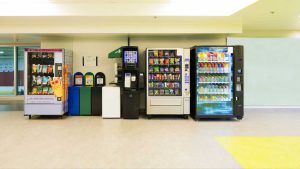You might have used the vending machine multiple times to munch on your favorite snack. But have you ever wondered where did vending machine originate from and who invented it? Let’s dig deep into the history of vending machine in different countries.
The first vending machine was constructed by Heron of Alexandria (Mechanicus, about 100 BC).After inserting a coin, holy water was dispensed. For more than 100 years people have been able to buy goods and services from vending machines. The first commercial vending machines were built at the end of the 80’s of the 19th century. On 13 March 1908, the first stamp and postcard-vending machine of the world was installed in front of the Hotel des Postes.
Vending machines are used in different markets, in the retail trade for the selling of food and non-food items as well as convenience products. Selling cold and hot drinks was the predominant business in the past, but at present, the variety of goods and services marketed with vending machines is steadily increasing. Vending Associations in different countries define vending differently.
Basically, vending is defined as the selling of products through vending machines, which are “coin operated machines for the sale of small articles”. Additionally, vending machines can be designed for the sale of large quantities of various products, e.g. in Japan, one can buy ten-kilo bags of rice from a vending machine. Furthermore, for a couple of years, it has been possible to pay for goods and services by credit card which has to be put in the vending machine’s slot for cards.
The American Association NAMA (National Automatic Merchandising Association) states that “vend is the delivery of a single unit of merchandise”. In the US, vending is highly connected with the slogan “Coffee, Candy, Cola”. “Coffee” symbolizes the sale of hot drinks like coffee, hot chocolate, tea, but also soups; the term “Candy” represents sweats, and “Cola” replaces the enumeration of different soft drinks. In the very beginning, the vending industry started with the Cs-concept, coffee, cup soda, candy and cigarettes, and later on the range grew to almost 8 Cs -coffee, candy or confections, chips, cold drinks, canned drinks, cigarettes, cold cup and commissary.
In Europe vending includes a wider range of products (EVA, European Vending Association). The Vending Association in Germany (BDV, Bundesverband der Deutschen Vending Automaten-Wirtschaft e.V.) defines vending as the selling of everyday essentials, especially food and drinks through vending machines. Producers of machines, operators and different associations use the term vending for all kinds of food and drinks, but they include non-food products as well.
The Austrian Association (ÖVV, Österreichische Verkaufsautomaten Vereinigung) defines all machines that sell goods, including food, drinks, photos, parking-tickets as vending machines; but copying-machines, telephones, lockers, washing-machines, pin balls, slot machines, etc. are also included. The BDV excludes machines which offer amusement features from the vending industry.
Now that you know about the history of vending machines, next time you go to get your favorite soda you would know how much this machine has developed overtime with changing needs of the evolving world.






